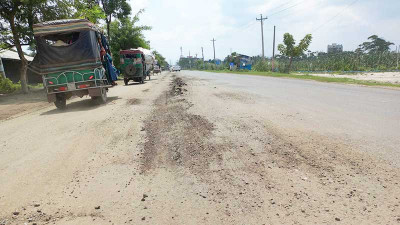
Bangladesh Bank made several projections two years
ago regarding the economic stability of the country in the post-Covid period. Bonik
Barta made a two-part series on the projections of the central bank. Here is
the first one-
Bangladesh Bank produced a special publication in
March 2021 on the country's economic stability and outlook in the post-Covid
period. The report of the Financial Stability Department projected that $10
billion will be added each year to the country's forex reserves in 2022 and
2023. In total, the country's reserves would reach $70 billion by the end of
2023. Alas! The projection didn't come into a reality. Rather the forex reserve
depleted near to $20 billion.
The special publication titled 'Economic and
Financial Stability Implications of Covid-19: Bangladesh Bank and Government's
Policy Response' shared the projection of reserves over the next two years. It
was forecasted that at the end of 2021, the foreign exchange reserves of the
country would be at $49.59 billion. It would further reach $59.42 billion at
the end of the next year. Finally, it will be extended to $69.15 at the end of
2023.
Bangladesh Bank's observation on the special publication
was, 'In 2020, the size of reserves has increased at a large rate even amidst
Covid-19. Remittances and the high flow of foreign loans played a major role in
this. The increase in reserves has also been due to the recovery of exports
against the decline and slowdown in the payment of imports.
Selim Raihan, executive director of the South Asian
Network on Economic Modeling (SANEM), a private research organization, believes
that it’s not clear on which parameter Bangladesh Bank projected the reserves.
He told Bonik Barta, "We may raise questions on the methods of the
research undertaken by the central bank. I don't find any merit in Bangladesh
Bank's research report. They didn't take into account many things that happened
in the last two years. Economic mishaps may
happen at any time which is not always foreseeable. My question is, why does
the economy come to such a fragile state? Each country's economy has its own
resilience against shocks. Where did our resilience go? It means our economy
has not grown enough to withstand shocks.
Mr. Raihan, also a professor of Economics at the University
of Dhaka sees the wrong policy of Bangladesh Bank as the reason behind the depletion
of reserves. He said, "For the last few years, the exchange rate of the dollar
was artificially fixed. When reserves were strong, the exchange rate could be
left to the market. But that was not done. Bangladesh Bank is continuously trying
to maintain the value of the Taka by selling dollars from the reserves. If this
continues, the situation in the reserve will worsen. The crisis has developed so
much now that if one side is dammed, the other side is drying up.
The highest reserve in the country's history was in
August 2021. According to the central bank's own accounting system, the reserves
crossed $48 billion at that time. After this, the fall of reserves began.
Reserves have fallen by an average of $1 billion per month over the last two
years. On October 18 this year, reserves stood at $20.95 billion as per international
standard (BPM6).
Concerned officials of the central bank said that
banks have to sell at least $1 billion from reserves every month to pay their
import liabilities. Besides, the drop in reserves is also increasing for paying
the government's loan. In the first week of the next month (November), around $130-140
million in LC liabilities has to be paid to the Asian Clearing Union (ACU). Then
the reserves will fall to $19 billion in one blow.
Bangladesh Bank began to follow international
standards in July this year in the calculation of foreign exchange reserves. It
is being pursued as a condition of getting a loan from the International
Monetary Fund (IMF). Since 2012, IMF member countries have been calculating
reserves according to the Balance of Payments and Investment Position Manual
(BPM6). But Bangladesh Bank took almost an age to start it. Reserves calculated
according to BPM6 principles are also not net or actual reserves of Bangladesh.
A number of short-term liabilities, including SDRs from the IMF, are excluded in
calculating net reserves. Following this, Bangladesh's net reserves are now
around $17 billion. However, according to Bangladesh Bank's own calculation
system, the amount of reserves on October 18 was shown $26.68 billion.
In response to reserves projection and contrast
situation of reality, the Chief Economist of Bangladesh Bank, Dr. Md. Habibur
Rahman told Bonik Barta, "If one knew what would happen in the future,
there would be no need to study economics. We cannot see the future, that’s why
economics and economists are needed. When the Bangladesh Bank projected
reserves, there was no Russia-Ukraine war. When any aspect of the economy is
projected, it is based on a number of assumptions. If those assumptions don’t
come true, the projection will be wrong naturally. Reserve projections based on
assumptions two years ago have not happened. Consequently, the reserve has
fallen instead of increasing.
Bangladesh Bank put their blame solely on the Russia-Ukraine
war for the abnormal decrease of reserves. But from the data of the central
bank we found, the depletion of reserves began six months before the start of the
Ukraine war. The Russia-Ukraine war started in the last week of February 2022
but Bangladesh Bank started selling dollars from reserves in August 2021. Only
in the FY2021-22, the central bank's sale of dollars from the reserve was $7.62
billion. A record $13.58 billion was sold from reserves in the FY2022-23. In the three and a half months of the current FY2023-24,
more than $4 billion have to be sold from the reserves. Bangladesh Bank started
selling these dollars mainly to pay the import letter of credit (LC)
liabilities of the country’s banks and foreign loans.
Bangladesh Bank had reined in the country's imports
since the beginning of the 2022-23 fiscal year to reduce the dollar crisis. The
conditions for opening LCs have been tightened. Banks also reduced their LC
openings due to the dollar crunch. Consequently, at the end of the fiscal year,
the number of imports decreased by about 16%. In the first two months
(July-August) of the current fiscal year, the amount of imports has decreased
by 22.47%. Banks are not able to open LC for the import of daily necessities
due to the dollar crunch. Besides, many banks in the country are still failing
to pay LC liabilities on time.
The central bank couldn’t be successful in reducing
the dollar crisis by curtailing imports significantly. Rather, the big disaster
in remittances has recently added to this pain. In the first three months
(July-September) of the current fiscal year, the remittance flow has decreased
by 13.34%. Last September, remittances to the country dropped to $1.34 billion,
the lowest in the last 41 months. Concerned stakeholders of this sector believe
that there has been a big decline in remittances due to Bangladesh Bank's
strict stance on the dollar exchange rate. From the beginning of this October,
the central bank once again adopted a liberal policy regarding the dollar rate.
As a result, remittance flow has increased in the first 20 days of this month. Till
October 20, remittances of 125 million dollars have arrived in the country
through banks.
However, the amount of dollars entering into the
country is still going out more than that. Due to this, the country's financial
account has gone negative flow. The financial account deficit in 2022-23 was
$2.14 billion, the highest in the country's history. In the first two months
(July-August) of the current fiscal year, the financial account deficit has
exceeded $2 billion. Considering this, concerned believe that the dollar crisis
or the fall of reserves won’t decline soon.
Ignoring the recommendations from economists,
Bangladesh Bank maintained a strong position of Taka against the dollar for the
past decade. At the beginning of last year, the country's exchange rate per
dollar was at 85 taka. Now banks are trading per dollar at 110 taka and 50
paisa. During this period, the taka has depreciated by about 30% against the greenback.
In the history of the country, such a large depreciation of money was never
seen before. Currently, the country's retail market (curb market) dollar is
trading at 119-120 taka.
When asked about the fall of reserves, Dr. Ahsan H.
Mansur, an economist told Bonik Barta, "Low-interest loans were available
in the global market two years ago. Imports were completely reduced. The import
duty did not have to be paid. In contrast, there was a large growth in
remittances. There was no pressure on the dollar as foreign travel stopped.
Then, without doing much, the government and Bangladesh Bank were silent observers.
They thought the economy was flying high.
Mr. Mansur, also the executive director of the Policy
Research Institute (PRI) added further, "At that time, the reserves made a
sudden leap from 30 to 48 billion dollars in one blow. Bangladesh Bank thought
the reserves would continue to increase at that rate. A scramble for loans from
the reserves to the private sector began. Some of us warned them about the
risks of their adventure. But who cares?
Two years later, everyone is watching the reality and there is nothing but
lamentations all around. If you don't take the right steps at the right time
the economy can never be sustainable.
Translated by Mehedi Mamun






